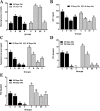Contemporaneous effects of diabetes mellitus and hypothyroidism on spermatogenesis and immunolocalization of Claudin-11 inside the seminiferous tubules of mice
- PMID: 29940839
- PMCID: PMC6019809
- DOI: 10.1186/s12861-018-0174-4
Contemporaneous effects of diabetes mellitus and hypothyroidism on spermatogenesis and immunolocalization of Claudin-11 inside the seminiferous tubules of mice
Abstract
Background: Diabetes and hypothyroidism produce adverse effects on body weight and sexual maturity by inhibiting body growth and metabolism. The occurrence of diabetes is always accompanied with thyroid dysfunction. Thus, it is important to take hypo- or hyper-thyroidism into consideration when exploring the adverse effects caused by diabetes. Previous reports have found hypothyroidism inhibits testicular growth by delaying Sertoli cell differentiation and proliferation. Hence, by establishing a mouse model of diabetes combined with hypothyroidism, we provided evidence that poly glandular autoimmune syndrome affected testicular development and spermatogenesis.
Results: we mimicked polyglandular deficiency syndrome in both immature and prepubertal mice by induction of diabetes and hypothyroidism, which caused decreases in serum concentrations of testosterone and insulin like growth factor 1 (IGF-1). Such reduction of growth factor resulted in inhibition of testicular and epididymal development. Moreover, expressions of Claudin-11 were observed between Sertoli cells and disrupted in the testes of syndrome group mice. We also found reduced sperm count and motility in prepubertal mice.
Conclusions: This mimicry of the diabetes and thyroid dysfunction, will be helpful to better understand the reasons for male infertility in diabetic-cum-hypothyroid patients.
Keywords: Claudin-11; Diabetes; Epididymis; Hypothyroidism; Spermatogenesis; Testis.
Conflict of interest statement
Ethics approval
The experimental protocols involving mice were conducted in accordance with the Guide for the Care and Use of Laboratory Animals prepared by the Institutional Animal Care and Use Committee of Nanjing Agricultural University, China. Permission use of laboratory animals in our university was certificated by No. SYXK (Su)2017–0007 and the ethics approval number of this project was NAU2015018 from our university ethics committee.
Consent for publication
Not applicable.
Competing interests
The authors declare that they have no competing interests.
Publisher’s Note
Springer Nature remains neutral with regard to jurisdictional claims in published maps and institutional affiliations.
Figures







Similar articles
-
Establishment, maintenance and functional integrity of the blood-testis barrier in organotypic cultures of fresh and frozen/thawed prepubertal mouse testes.Mol Hum Reprod. 2017 May 1;23(5):304-320. doi: 10.1093/molehr/gax017. Mol Hum Reprod. 2017. PMID: 28333312
-
Adverse effects of neonatal hypothyroidism on Wistar rat spermatogenesis.Endocr Res. 2002 Aug;28(3):141-54. doi: 10.1081/erc-120015051. Endocr Res. 2002. PMID: 12489564
-
Effects of concomitant diabetes mellitus and hyperthyroidism on testicular and epididymal histoarchitecture and steroidogenesis in male animals.J Zhejiang Univ Sci B. 2016 Nov.;17(11):850-863. doi: 10.1631/jzus.B1600136. J Zhejiang Univ Sci B. 2016. PMID: 27819132 Free PMC article.
-
Effects of hyper- and hypothyroidism on the development and proliferation of testicular cells in prepubertal rats.Anim Sci J. 2017 Dec;88(12):1943-1954. doi: 10.1111/asj.12883. Epub 2017 Aug 7. Anim Sci J. 2017. PMID: 28782242
-
Irradiation affects germ and somatic cells in prepubertal monkey testis xenografts.Mol Hum Reprod. 2017 Mar 1;23(3):141-154. doi: 10.1093/molehr/gax003. Mol Hum Reprod. 2017. PMID: 28130393
Cited by
-
Effects of hyperthyroidism and diabetes mellitus on spermatogenesis in peri- and post-pubertal mice.Front Endocrinol (Lausanne). 2023 Aug 15;14:1191571. doi: 10.3389/fendo.2023.1191571. eCollection 2023. Front Endocrinol (Lausanne). 2023. PMID: 37654561 Free PMC article.
-
Resveratrol Protects against Restraint Stress Effects on Stomach and Spleen in Adult Male Mice.Animals (Basel). 2019 Sep 27;9(10):736. doi: 10.3390/ani9100736. Animals (Basel). 2019. PMID: 31569722 Free PMC article.
-
Effects of Vincamine on Testicular Dysfunction in Alloxan-induced Diabetic Male Rats.Iran J Pharm Res. 2023 Jan 20;21(1):e132265. doi: 10.5812/ijpr-132265. eCollection 2022 Dec. Iran J Pharm Res. 2023. PMID: 36942057 Free PMC article.
References
Publication types
MeSH terms
Substances
Grants and funding
LinkOut - more resources
Full Text Sources
Other Literature Sources
Medical
Molecular Biology Databases
Miscellaneous

